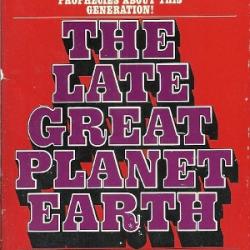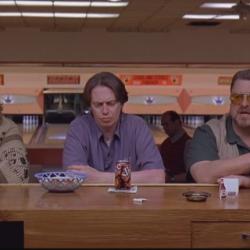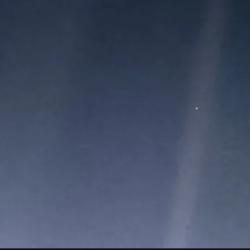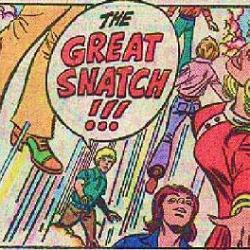Nicolae: The Rise of Antichrist; pp. 183-189
Chapter 10 begins unremarkably enough, but then, suddenly, it grabs the reader by the lapels and hurls them forcibly out of the story. This happens twice in the next half-dozen pages.
I don’t mean that the reader encounters a few little hiccups or rough spots in the story. These are insurmountable obstacles that slam down in front of you. The sort of thing that causes one to say, “No. No that cannot be.” And then to close the book, get up out of the chair and walk away.
I’m not talking here about the sort of thing that merely makes one realize one is reading a poorly written book. Nor even about the kind of thing that might provoke a reader to post a no-star review on Amazon. What happens here, rather, is the sort of thing that ought to make readers contact the CFPB to inquire about the possibility of criminal penalties for Tim LaHaye, Jerry Jenkins and Tyndale House publishers. It’s the sort of thing that ought to lead to a lucrative class-action lawsuit on behalf of anyone who ever purchased or read this book. Perhaps a class-action lawsuit on behalf of all readers everywhere, living or dead. And all writers, editors, publishers, Christians, Jews and English speakers.
It’s that bad. And it happens, as I said, twice in these six pages. We’re going to deal with just the first of those this week.
Buck Williams has hailed a cab from his hotel to return to the Western Wall, where he hopes to ask “Moishe and Eli” again for help in finding his friend the former Rabbi Tsion Ben-Judah. They’ve already told him that Tsion is in Galilee, but he’s hoping for more specific instructions. “How far to Galilee?” he asks the cab-driver.
The cabbie took his foot off the accelerator. “You go to Galilee? Wailing Wall in Jerusalem.”
Buck waved him on. “I know. Wailing Wall now. Galilee later.”
The cabbie headed for the Wailing Wall. “Galilee now Lake Tiberius,” he said. “About 120 kilometers.”
Here is evidence that Jerry Jenkins may have done a tiny bit of research, likely involving a map of Israel and the West Bank. So Jenkins has looked at such a map– at least enough to approximate the distance to, and the spelling of, Tiberias. Remember that later.
For now, though, brace yourself, because here comes the first Impossible Thing in this chapter:
Hardly anyone was at the Wailing Wall or even in the entire temple mount area at this time of the night. The newly rebuilt temple was illuminated magnificently and looked like something in a three-dimensional picture show. It seemed to hover on the horizon. Bruce had taught Buck that one day Carpathia would sit in that new temple and proclaim himself God. The journalist in Buck wanted to be there when that happened.
“The newly rebuilt temple …”
This is how readers learn that the Temple in Jerusalem has been rebuilt. We’ve been wandering around Jerusalem with Buck Williams for a couple of chapters now, but until this off-handed description of background scenery here, this is the first we’ve heard of this. We read a multi-page account of Buck’s earlier visit to “the Wailing Wall” and yet, somehow, nothing in that scene saw fit to mention that above that wall now sat “the newly rebuilt temple.”
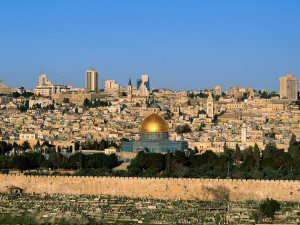
That’s astonishing just on the basic level of describing the scenery, but what’s even more astonishing is that the authors don’t seem to see any significance in the Temple other than as just scenery.
I don’t know if you’ve ever read the Hebrew scriptures — the collection of 39 books that make up what we Christians call the “Old Testament.” That’s where we read about the Temple in Jerusalem. A lot. It’s not a minor part of the story of those books. It is a central, essential fact at the heart of most of the Hebrew Scriptures. It is also a really important factor in much of the New Testament.
It is not possible to understand anything about Judaism without understanding the meaning and significance of the Temple in Jerusalem. It is not possible to understand much about Christianity without understanding the meaning and significance of the Temple in Jerusalem.
Tim LaHaye and Jerry Jenkins do not see anything meaningful or significant about the Temple in Jerusalem.
Here in Nicolae, for the authors, the presence of the Temple is meaningless except as some lights in the background behind the Western Wall. For the authors, the rebuilt Temple means nothing. It changes nothing.
That is simply impossible. And it renders everything else in this chapter impossible as well. Buck Williams is in Jerusalem, and yet it is a kind of Jerusalem that would be unchanged by the rebuilding of the Temple — which is to say it is not Jerusalem. It is nothing at all like Jerusalem.
Buck is looking for Tsion Ben-Judah, who is in hiding because he’s stirred up controversy among Jewish religious authorities for preaching that Jesus was the Messiah (which, in these books, is a novel concept previously unheard of). The “controversy” sparked by Tsion’s 2,000-year-old theory wouldn’t merit a single column inch or a single second of broadcast time amidst the turmoil and flood of religious reconstruction and rebuilding that would accompany the reconstruction and rebuilding of the Temple. Tsion’s “Jews for Jesus” message might have garnered a tiny bit of attention if his name had been Tsion Cohen, but it still wouldn’t have distracted anyone from the more pressing questions about the reconsecration of the holiest site, the recommissioning of priests, the resumption of sacrifices, tithes and offerings, and the countless other huge, world-changing consequences of “the newly rebuilt temple.”
Tsion would be a footnote. His stadium crusades would fizzle. Even with the added draw of fire-breathing assistants he couldn’t hope to compete with “I was glad when they said unto me, let us go into the house of the Lord.”
So Buck Williams is in not-Jerusalem, looking for a man who is in hiding even though no one has the time to care to look for him, and he’s taking a cab to the “Wailing Wall.” This is a holy site in the actual Jerusalem because it is the most visible remnant of the Second Temple. Buck is going there to visit the Two Witnesses. But why are they preaching there, at the foot of the Temple Mount, instead of “the court outside the temple” — which is where they seem to preach in Revelation? And why do the authors weirdly behave as though the Western Wall would remain a holy site more revered than the Temple itself? Why do they still insist on calling it the “Wailing Wall” — the “place of weeping” — when it’s no longer necessary for those who gather there to weep over the absence of the Temple?
I can’t do justice to the enormity of the impossibility of what we have here. LaHaye and Jenkins have given us an insignificant Temple. To counter that I would need to convey the full immensity of the Temple’s significance — in Judaism and in Christianity. I’m nowhere near enough of a theologian to do that. No one person could be.
All I can do is flail about sputtering … but, but but … But what about Moishe? He’s supposed to be the patriarch Moses, raised from his grave in the land of Moab and here, at long last, in the Promised Land. Moses, who spent his whole life striving and straining to reach this place, now just spends all day, every day, crouching amid ancient ruins (not that ancient to him, I suppose) at the bottom of a hill. That hill dominates this city, the city of David (“Eli” could explain to Moses who David was). And at the top of that hill stands not a tabernacle, not a tent, but a temple — the Temple. And yet, in this story, Moses never bothers to walk up the hill.
Nicolae is the third book in a series that eventually sprawled to include 16 titles. Want to write a 16-novel series yourself? Here’s all the premise you’ll ever need: “The newly rebuilt temple.” Take the world, just as it is, and make that single change. Then all you need to do is chase down as many of the implications as you can. What would that mean theologically, politically, economically, culturally …? Even after your first 16 books you still won’t have exhausted all of the possibilities.
This is why Jews, Christians, Muslims and Mormons all only tend to speak of the rebuilding of the Temple in cosmic terms involving the end of the world. We can’t imagine it otherwise. The implications are too complicated and too big.
For Tim LaHaye and Jerry Jenkins, though, “the newly rebuilt temple” means nothing. It’s a bit of background flavor for Buck Williams to view from the window of his cab. And it’s another check on LaHaye’s End Times Prophecy Check List. But that’s all.
“Bruce had taught Buck that one day Carpathia would sit in that new temple and proclaim himself God,” L&J write. The “prophecy” there comes from the book of Daniel. In LaHaye’s scheme, Daniel gets mixed into a hodge-podge of exilic and post-exilic Old Testament passages that he treats as a single prediction of the rebuilding of the Temple in the last days.
As with all of his “prophecy” studies, LaHaye is more concerned with sequence than with meaning, so all he really cares about is making his check list. What does he think these prophecies prophesy about the Temple? That it will be rebuilt, defiled and then destroyed. That sequence is the only meaning he sees and the only meaning he attributes to the Temple. For LaHaye, that’s what the Temple is for.
Feh. All I can do is try to wash that away. Here’s the fourth movement of Brahms’ Requiem, based on the words of Psalm 84.
(I went with the rendition by the Mormon Tabernacle Choir because: A. I couldn’t find a contemporary guitar, cello, piano, etc., arrangement, which is a crying shame; B. the LD Saints know what they’re doing when it comes to choral music; and C. the slight disconnect I have about hearing Mormons sing the words of Psalm 84 and the difference they attribute to the words “how lovely is thy dwelling place” is a theologically fruitful reminder of the same kind of disconnect Jews will experience when hearing other Christians recite those words with the differences we attribute to them. Seriously, though, I’d like to hear, say, Sufjan Stevens or the Polyphonic Spree or Sarah Jarosz and Alison Krauss do this one.)



